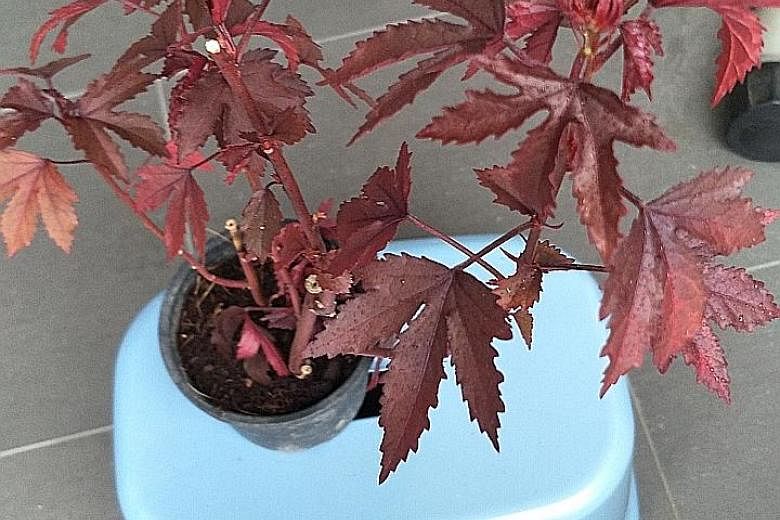Leaves of Cranberry Hibiscus edible
What is the name of this plant (above) and does it have medicinal value?
Jong Fong Kam
The plant is known via a range of common names that include Cranberry Hibiscus, False Roselle and Red Hibiscus. Its botanical name is Hibiscus acetosella.
It is a plant that needs direct sun to grow well and for its intense red foliage colour to be exhibited.
Its leaves are edible and slightly sour. They are commonly added to salads for colour and flavour.
The red flowers, and possibly the leaves, have been documented to be used to make tea, somewhat similar to the use of the red calyces of the Roselle (Hibiscus sabdariffa). They possibly contain vitamin C and some antioxidants that are regarded as good for health.
Wishbone Flower often sold as potted flowering plant

This plant (above) started to sprout after I left a pot outside my home for a week. It has now been a month. The flower is beautiful, but is the plant a weed? What is its name? It seems to be able to grow anywhere and is everywhere.
Soh Kai Han
The plant is commonly known as the Wishbone Flower.
If you look closely at the flower, the two stamens come very close together in a manner that makes them look like the wishbone of a chicken, hence the common name.
The botanical name of this plant is Torenia fournieri.
This flowering plant grows as a long-lived annual in Singapore.
It is often sold as a potted plant during Chinese New Year for its colourful, cheerful blooms, and readily self-seeds in the garden.
Hence, random seedlings may emerge, like what you have observed.
Mempelas climber is not commonly cultivated in Singapore

What is this fragrant plant (above) at Sungei Buloh Wetland Reserve?
Jeffrey Tan
From the shape of the leaves and flowers, the plant is a climbing one that appears to be Tetracera loureiri, commonly known as Mempelas.
It produces sprays of attractive, scented flowers.
This climber belongs to the same family, Dilleniaceae, as the native shrub Simpoh Ayer (Dillenia suffruticosa), whose large leaves were used to wrap foods in Singapore years ago.
Potting media for orchid needs to be of the correct grade size

Is this plant (above) beyond help? What can I do to help it flower?
Katherine Koo
The picture shows some keikis, or small plantlets, of an orchid, most likely a dendrobium.
The plantlets are showing signs of drying up, a result of the plant being potted in overly large charcoal chips.
Overly large chips do not hold water and dry up quickly.
You should pot the plantlets in smaller charcoal chips of, say, 2 to 3cm in size - this will leave smaller gaps between them, where they will hold some moisture while permitting aeration. Depending on the growing conditions, you may need to water the pot twice a day to ensure the plantlets do not dry out excessively.
Lacewing larvae welcomed in garden

I saw these (above) on the metal portion of a lift. What are they?
Ling Cheng
These are the eggs of the lacewing.
The lacewing is a beautiful winged insect that is welcomed in the garden. The larvae of these insects often feed on the eggs and immature stages of small, soft-bodied pests such as aphids, spider mites, thrips, whitefly and mealybugs. However, the adults feed on nectar and pollen.
To have such beneficial insects in the garden, it is vital to practise environment-friendly pest and disease control using organic approaches.
The use of broad-spectrum chemical pesticides will reduce the population of such beneficial insects in the garden.
• Answers by Dr Wilson Wong, an NParks-certified practising horticulturist and park manager. He is the founder of Green Culture Singapore and an adjunct assistant professor (Food Science & Technology) at the National University of Singapore.
• Have a gardening query? E-mail it with clear, high-resolution pictures of at least 1MB, if any, and your full name to stlife@sph.com.sg

